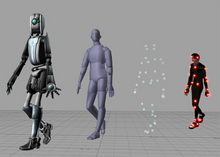This article needs additional citations for verification. (May 2013) |
| Three-dimensional (3D) computer graphics |
|---|
 |
| Fundamentals |
| Primary uses |
| Related topics |
Global illumination[1] (GI), or indirect illumination, is a group of algorithms used in 3D computer graphics that are meant to add more realistic lighting to 3D scenes. Such algorithms take into account not only the light that comes directly from a light source (direct illumination), but also subsequent cases in which light rays from the same source are reflected by other surfaces in the scene, whether reflective or not (indirect illumination).
Theoretically, reflections, refractions, and shadows are all examples of global illumination, because when simulating them, one object affects the rendering of another (as opposed to an object being affected only by a direct source of light). In practice, however, only the simulation of diffuse inter-reflection or caustics is called global illumination.
- ^ "Realtime Global Illumination techniques collection | extremeistan". extremeistan.wordpress.com. 11 May 2014. Retrieved 2016-05-14.

